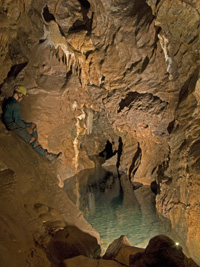 |
Cave Life of Devon |
 |
| |
| HOME |
| INTRODUCTION |
| LIFE IN THE ENTRANCE |
| LIFE IN THE CAVE |
| CONSERVATION |
| GLOSSARY |
| ACKNOWLEDGEMENTS |
| |
| Cave Climate |
| Adaptations |
Introduction |
||
The caves of Devon lie in Devonian limestone which is much older (398-385 million years BP) than the Carboniferous limestone in which most other British caves are formed. Outside of Devon the only other caves in Devonian limestone are Holwell Cavern in the Quantock Hills of Somerset and two minor caves at Cremyll in East Cornwall, near Plymouth. In Devon there are several blocks of exposed limestone scattered throughout the county, mainly in the south. The main areas are around Plymouth, the Torbay area, Chudleigh Rock and close to the southeast edge of Dartmoor. This latter area consists of a line of Devonian limestone exposed along the valley of the River Dart, near the village of Buckfastleigh and is where the best developed caves are found. Other smaller outcrops exist around the county, including a small outlying formation in North Devon, near Ilfracombe, in which is found Napp’s Cave, containing good aragonite formations. Most of the caves are small in extent. The largest and best known caves are the Baker’s Pit - Reed's Cave System (3.6km), and Pridhamsleigh Cavern (1.1 km), both near Buckfastleigh, along with Afton Red Rift (0.4km), between Newton Abbot and Totnes. Other notable caves in the county include Kent’s Cavern in Torquay, open as a show cave and renown for its finds of bones and evidence of settlement by early man; Bunker’s Hole, which contains many beautiful aragonite fromations; and Joint-Mitnor Cave, which contains the richest deposit of interglacial remains yet discovered in Britain. Many of the Devon caves are important roosting sites for Greater and Lesser Horseshoe bats.
|

